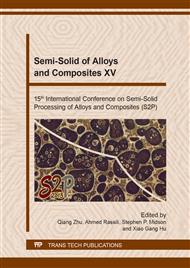p.302
p.311
p.318
p.326
p.333
p.339
p.347
p.354
p.361
Development of Slurry Preparation Method by Applying Mechanical Vibration
Abstract:
The preparation of a semi-solid slurry with fine and spherical solid particles dispersed in the liquid phase is a key technology for the semi-solid process. In this study, we have developed the slurry preparation method by applying mechanical vibration for JIS AC4CH (equivalent to A356 in the ASTM standard) and ADC12 (equivalent to A383 in the ASTM standard) aluminum alloys. In this method, the mechanical vibration was applied to the aluminum alloys during cooling from a liquid state to semi-solid state. The shape of the particle was varied by controlling vibration conditions. Therefore, we investigated the effect of conditions on mechanical vibrations. There are four parameters which are frequency, acceleration amplitude, velocity amplitude and displacement amplitude in the mechanical vibration. Among these parameters, the velocity amplitude had highest effects on the shape of solid particles. By properly controlling of the frequency and the velocity amplitude, the slurry with fine and spherical solid particles could be obtained. Moreover, the fraction solid of slurry could be controlled by varied initial liquid temperature. Especially, ADC12 aluminum alloy has low liquid-solid coexistence temperature range, so it is not considered to be suited for the semi-solid process. However, by using this mechanical vibration method, the semi-solid slurry could be obtained stably. This method is expected to be effective for the semi-solid high-pressure die-casting process.
Info:
Periodical:
Pages:
333-338
Citation:
Online since:
January 2019
Authors:
Price:
Сopyright:
© 2019 Trans Tech Publications Ltd. All Rights Reserved
Share:
Citation:


